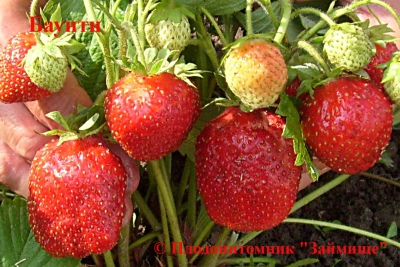
- Authors: Canada
- The size: large
- Weight: up to 30 g
- Yield rate: very high
- Ripening terms: mid-late
- Advantages: high vitamin C content, very tasty, resistant to fungal diseases
- Appointment: universal
- Description of the bush: spherical, erect, densely leafy
- Berry color: dark crimson
- Winter hardiness: medium
The Bounty strawberry bred in Canada has been successfully tested in the Russian climate. The variety received excellent marks for its vitamin properties - the berries contain a lot of vitamin C. Strawberries are universal in their purpose, adapt well to dry seasons, and are unpretentious in cultivation.
Description of the variety
Bounty is a strawberry with beautiful spherical bushes, decorated with erect dense leafy shoots. She is vigorous, strong. The leaf plates are large, dark green in color.
Ripening terms
Strawberries of this variety have a medium late ripening period. It ripens in the second half of summer, bears fruit for 3-4 weeks.
Yield
The Bounty is characterized by a very high yield. About 1 kg of berries are harvested from the bush per season.
Berries and their taste
Strawberry Bounty not in vain received 5 out of 5 possible points on the tasting assessment. Its balanced taste, pronounced aroma, tender and dense pulp are liked by both children and adults. Outside, the skin of the berry is dark crimson, inside it is red. The fruits have a characteristic conical shape, large size, reaching a mass of up to 30 g.
Growing features
Bounty strawberries can be planted in different patterns - from nesting to carpet, but most often they are placed in separate bushes or rows. The more the ridge is thickened, the smaller the berries will be. Seedlings with a closed root system are preliminarily placed in a dark place for 24-48 hours before being transferred to open ground.




Site selection and soil preparation
The main criterion that should be followed when choosing a place for strawberry bushes is the degree of illumination of the beds. It is recommended to plant them in the sun, in fertile soil rich in fertilizers. Since the root system develops superficially, it is not necessary to deepen the nutrient medium. It is enough to dig up the beds with the addition of deciduous humus or organic matter, and then let them settle.

Pollination
The shrubs produce enough pollen during the flowering period. It is not necessary to additionally stimulate the formation of ovaries using cross-pollination.
Top dressing
In order to get a plentiful and rich harvest, Bounty strawberries have to be fed regularly. Before fertilizing, the soil is abundantly moistened, otherwise the roots can be burned. The first stage of feeding occurs in the spring, before the leaves appear. The plant needs nitrogen, so fertilizers are introduced into the soil to stimulate the growth of green mass.
Then, already in the summer months, but before the ovaries appear, the bushes need sources of potassium. Complex fertilizers that additionally include magnesium work well. After flowering, the plants are powdered with wood ash, at the same time fertilizing the soil and repelling harmful insects. At the end of September, when the harvest is harvested, the bushes are fertilized with potassium-phosphorus compounds. Such feeding will help provide plants with a comfortable wintering.

One of the important techniques in strawberry care is feeding. Regular fertilization guarantees a rich harvest. There are several different ways to feed strawberries, and each of them is designed for a specific period of plant development. During flowering, fruiting and after it, feeding should be different.
Frost resistance and the need for shelter
Indicators of winter hardiness are average. It is better not to leave plants without shelter in cold climates.

Diseases and pests
The variety is considered resistant to fungal diseases. Practically unaffected by gray rot. But leaf plates are susceptible to sunburn. And also it is worth protecting the bushes from verticillosis, root late blight. Among the pests, the most dangerous is the strawberry mite; treatment from it is mandatory.

Strawberries are often subject to many dangerous diseases that can seriously undermine their condition. Among the most common are powdery mildew, gray mold, brown spot, anthracnose, and verticillosis. Before buying a variety, you need to inquire about its disease resistance.
Reproduction
The bounty forms a mustache profusely. They are used to renew, rejuvenate plants in the garden. The resulting rosettes take root easily. With the carpet growing method, they are not removed, they are allowed to spread freely over the surface of the ridge.If the seedlings are to be transplanted, the rosettes are rooted in cups or containers.

Review overview
According to the reviews of those who have already appreciated the Canadian variety, Bounty can be called one of the latest fruiting varieties. Strawberries are praised for their beautiful, calibrated berries, suitable for subsequent sale, and the transportability of the fruit. Experienced gardeners recommend that you must mulch the soil in order to preserve the beauty and purity of the fruits during the harvesting period.
Negative reviews are associated with the plant's susceptibility to root lesions. With waterlogging of the soil, the problems intensify, the fruits begin to shrink. In addition, there is a change in the size of the berries, they become smaller over time.


















































































